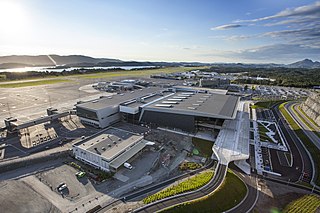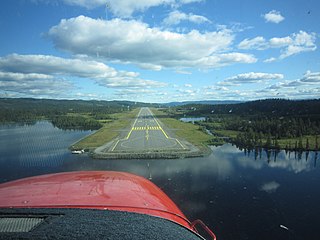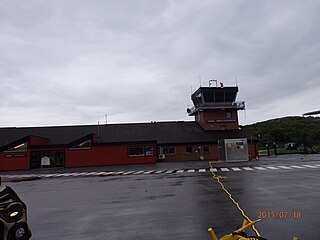
Kristiansund Airport is an international airport serving Kristiansund, Norway. It is situated at Kvernberget on the island of Nordlandet and is the sole scheduled airport serving Nordmøre. The airport features a 2,390-meter (7,840 ft) runway aligned 07/25. In addition to scheduled services operated by Scandinavian Airlines and Widerøe, it serves offshore helicopter traffic to the Norwegian Sea operated by CHC Helikopter Service. Kvernberget handled 314,084 passengers in 2018.

Bergen Airport, alternatively Bergen Flesland Airport or simply Flesland Airport, is an international airport located at Flesland in the city and municipality of Bergen, Vestland, Norway. Opened in 1955, it is the second-busiest airport in Norway, with 6,306,623 passenger operations in 2018. Flesland is operated by the state-owned Avinor. Until 1999, Flesland Air Station of the Norwegian Air Force was co-located at the airport.

Fagernes Airport, Leirin is a general aviation airport in Fagernes, in the municipality of Nord-Aurdal, Innlandet county, Norway. It has been an airport for passenger flights, serving Fagernes and the surrounding valleys of Valdres, Hallingdal and Gudbrandsdal in Southern Norway, 190 kilometres (120 mi) from Oslo. Opened in 1987, it was owned and operated by state-owned Avinor. The airport is located 822 metres (2,697 ft) above sea level, and has a 2,049-metre (6,722 ft) runway. It did provide a regional service for the local population to Oslo, subsidized by the Ministry of Transport, as well as charter services during winter serving the nearby ski resorts. In 2014, the airport had 6,393 passengers. The driving time Fagernes–Oslo, around 2½ hours, has made flights to Oslo unattractive; most passengers used the Oslo route for transfers. It has also been used for other destinations. The road has also been improved compared to how it was in 1987.

Kristiansand Airport, Kjevik is an international airport serving Kristiansand Municipality in Agder county, Norway. The airport is located in the district of Tveit in the Oddernes borough, about 16 kilometers (9.9 mi) by road and 8 kilometers (5.0 mi) by air from the center of town of Kristiansand. Operated by the state-owned Avinor, it is the sole airport in Southern Norway with scheduled flights. It has a 2,035-meter (6,677 ft) runway aligned 03/21 and served 1,061,130 passengers in 2018. Scheduled flights are provided by Scandinavian Airlines, Norwegian Air Shuttle, Widerøe, KLM Cityhopper and Wizz Air. The Royal Norwegian Air Force has a training center at the airport.

The Arendal Line is a 45-kilometer (28 mi) long railway line between Arendal and Simonstad in Norway. At Nelaug, 37 kilometers (23 mi) north of Arendal, the line intersects with the Sørland Line. The southern section is electrified and provides a feeder passenger service. The line originally ran 90 kilometers (56 mi) north from Arendal to Treungen and the lake Nisser, but the upper-most part has been removed. The line is owned by the Bane NOR and operated by Go-Ahead Norge using Class 69 trains.

Haugesund Airport is an international airport serving the Haugaland region in Norway. It is located just outside the town of Haugesund on the Helganes peninsula on the island of Karmøy in the municipality of Karmøy, Rogaland county, Norway. The airport features a 2,120-meter (6,960 ft) runway aligned 13/31. Scandinavian Airlines (SAS) and Norwegian Air Shuttle provide services to Oslo. Haugesund Airport also offers discounts on international routes and has some service from low-cost carriers. The airport handled 694,005 passengers in 2014.
Røros Airport is a regional airport located 2 kilometers (1.2 mi) from the town of Røros in Trøndelag county, Norway. The asphalt runway has the physical dimensions 1,740 by 40 meters and is aligned 14/32. Scheduled services are provided to Oslo by Widerøe. The main general aviation user is Rørosfly, a pilot school, and the aviation club Røros Flyklubb.

Båtsfjord Airport is a regional airport serving Båtsfjord Municipality in Finnmark county, Norway. It consists of a 1,000 by 30 meters runway and served 14,485 passengers in 2016. A further 14,663 landed and started at the airport without leaving the aircraft. Scheduled services are provided by Widerøe using the Dash 8 to Kirkenes, Hammerfest and other communities in Finnmark. The airport is owned and operated by the state-owned Avinor.

Bardufoss Airport is a primary airport situated at Bardufoss in Målselv Municipality in Troms county, Norway. The airport, which is the civilian sector of the Royal Norwegian Air Force's (RNoAF) Bardufoss Air Station, is operated by the state-owned Avinor. It consists of a 2,443-meter (8,015 ft) runway, a parallel taxiway and handled 218,451 passengers in 2014. Norwegian Air Shuttle (Norwegian) operates three daily flights with Boeing 737s to Oslo. The airport's catchment area covers central Troms.

Notodden Airport is a municipal regional airport at Heddal in Notodden, a municipality in Telemark county, Norway. The airport is mostly used for general aviation, and has extensive sailplane activity. In 2011, the airport had 5,078 aircraft movements and 3,423 passengers. The airport has a single 1,393-by-40-meter runway with flight information service and instrument landing system. In connection with the airport is a water aerodrome, which uses the lake of Heddalsvatnet for take-off and landing.

Tønsberg Airport, Jarlsberg is a general aviation airport located at Sem in Tønsberg, Norway. It consists of a 799-by-18-meter asphalted runway and a 900-meter (3,000 ft) taxiway. Jarlsberg is used for a variety of activities, including glider pilots, light and microlight aircraft, radio-controlled aircraft, parachuting and the annual air show Wings & Wheels. The airport is owned by Thor Solberg Aviation and operated by Jarlsberg Luftsportssenter.

Rørvik Airport is a regional airport located at Ryumsjøen, about 6 kilometers (4 mi) south of the town Rørvik in Nærøysund Municipality in Trøndelag County, Norway. The airport is owned and operated by the state-owned Avinor and serves Nærøysund Municipality and its surroundings. The airport has a 950-meter (3,117 ft) asphalt runway numbered 04–22. Widerøe flies to the airport with its Bombardier Dash 8 aircraft on contract with the Ministry of Transport and Communications. The airport opened in 1986 as a municipal airport. It was first served by Norving, but Widerøe took over the flights in 1988. The airport was nationalized in 1996.

Geilo Airport, Dagali is a private airport located at Dagali in Hol in Buskerud, Norway. It was previously a public airport that was both a regional airport and served international tourist charter airlines serving the nearby ski resorts centered on Geilo. The airport opened in 1985, but failed commercially and was eventually closed in 2003.

Hamar Airport, Stafsberg is a general aviation airport located at Stafsberg in Hamar, Norway. It features a 944-by-23-meter runway aligned 15–33 and is owned by Hamar Municipality. The airport is located in an area with very stable climate and good flying conditions.

Farsund Airport, Lista is an airport situated on the Lista peninsula in the municipality of Farsund in Agder county, Norway. The village of Vestbygd lies on the southwest side of the airport and the small village of Ore lies on the northeast side. The airport features a 2,990-meter (9,810 ft) concrete runway aligned 14/32. Previously it also had a 1,494-meter (4,902 ft) runway aligned 09/27. Farsund Airport, Lista is the civilian sector of the now closed Lista Air Station. Previously a regional airport, it is now only used for general aviation.

Lista Air Station was a military airbase situated on the Lista peninsula in Farsund, Norway. It features a 2,990-meter (9,810 ft) concrete runway aligned 14/32, and a 1,521-meter (4,990 ft) runway aligned 09/27. The facility was shared with Farsund Airport, Lista, which remains in operation.

Stavanger Airport, Forus is a former airport located at Forus in the intersection of the municipalities of Stavanger, Sola and Sandnes. It was built as a military air base by the Luftwaffe following the German occupation of Norway in April 1940. It was gradually expanded so that it by 1943 consisted of three runways, the longest 1,950 meters (6,400 ft). The airfield was connected by a 3.6-kilometer (2.2 mi) taxiway to Sola Air Station. The airport served as an offensive base during the Battle of Britain, and was afterwards made part of the defensive Festung Norwegen.
Båtsfjord Airport is a former regional airport located at Båtsfjorddalen just south of the village of Båtsfjord in Båtsfjord Municipality in Finnmark county, Norway. It consisted of an 800-by-30-meter gravel runway aligned 01–19 and had a simple terminal building. Construction of the airport was started a local aviation club in 1972 and was completed with a 600-meter (2,000 ft) runway in May 1973. The runway was extended the following year and in 1976 the airport was municipalized. From the start Norving operated air taxi and air ambulance flights. Following an upgraded terminal in 1978, the taxi services became scheduled and the Britten-Norman Islander was introduced to Kirkenes and Vadsø. From 1983 the Dornier 228 entered service on the Båtsfjord route.
Kautokeino Airfield is a general aviation aerodrome located in the village of Kautokeino in Kautokeino Municipality in Finnmark county, Norway. It consists of a 1,200-meter (3,900 ft) gravel runway, built by the Luftwaffe during World War II. It was rebuilt in 1958 by the Royal Norwegian Air Force to supply its radar station at Kautokeino. It is largely unused and is now owned by the Norwegian Directorate of Public Construction and Property and the Finnmark Estate. Local politicians have called for the aerodrome to be upgraded to a regional airport, but this has been rejected by Avinor.
Arendal Airport, Rådhuskaien was a water aerodrome in Arendal, Norway, which operated between 1935 and 1939. Situated at Rådhuskaien, it served the scheduled coastal seaplane service operated by Norwegian Air Lines.





















